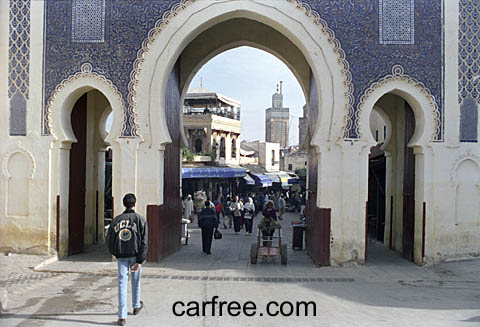
Looking through Bab Boujaloud into the Medina
The Medina of Fes-al-Bali
The medina is still surrounded by its original defensive walls, which are penetrated at irregular intervals by a massive gate, known as a "bab." Bab Boujaloud provides access to a newer area of the medina, with somewhat wider streets than the rest. The wide street just beyond the gate runs for less than 100 meters before tapering down to just a few meters. This is the center for budget tourists, and most of the hotels are located just within the gate. There are also several cafés and restaurants, small stores, and a bakery (that serves delicious bread!). The gate is one of the most intricately decorated in Fes. A minaret can be seen in the distance.
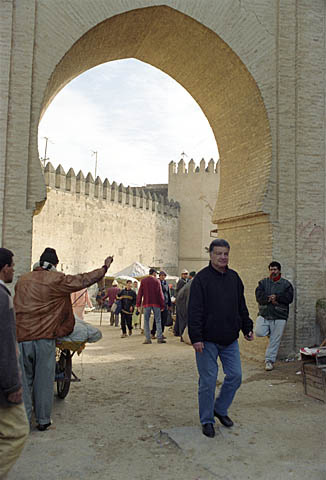
Gate, Fes-al-Bali
This gate is located near one of the major markets and serves as an important access route for many goods, especially fresh food. Notice that the gate has the same basic form as Bab Boujaloud, but lacks the decoration.
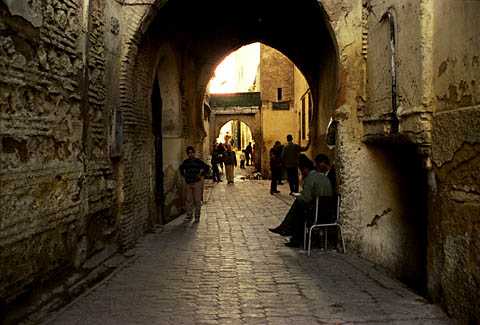
One of Many Portals Separating Neighborhoods, Fes-al-Bali
Each of the many neighborhoods in Fes-al-Bali is separated from the next by some form of gate. In some cases, these gates are elemental, consisting of only a heavy balk of timber across the street. This delineates the boundaries of a neighborhood.
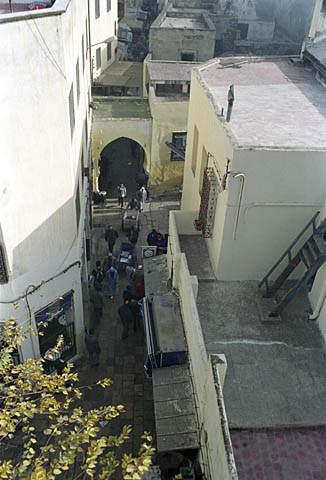
View from Above, Near Bab Boujaloud, Fes-al-Bali
This street is actually one of the wider streets in the medina and does see a small amount of truck traffic and a just enough motorcycles to be irritating. However, the street is very crowded at most times of the day, so motorized vehicles must proceed at a snail's pace. This street continues to narrow as it approaches the center of the medina, and motorized traffic soon disappears.
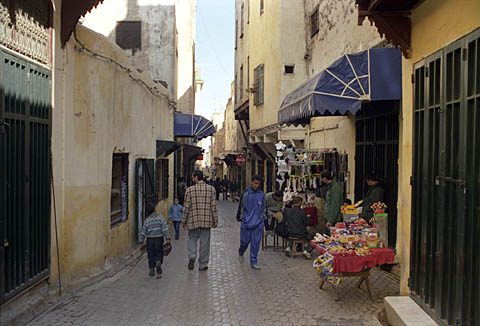
Street Near Bab Boujaloud, Fes-al-Bali
This is just a hundred meters further on than the locale shown above, and already the street has narrowed sufficiently the motorized traffic can proceed only with difficulty. Notice the many shops, some of which are already closed for the day.
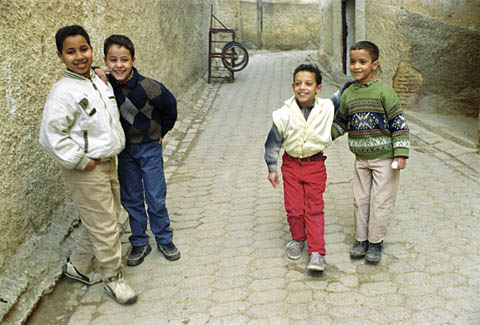
Boys Playing in a Side Street, Fes-al-Bali
A special sensitivity is required to photograph in Morocco. The nation is almost entirely Moslem, although it adheres to one of the moderate branches of that religion. However, the making of "graven images" is a taboo, to one degree or another, in all Islamic nations. Older people are especially likely to resent being photographed, and I was careful to keep their faces out of photographs unless I had their consent. Children, however, are another story. Boys will cluster around the camera, eager to be photographed. Girls often run and hide.
It is worth remarking that although our visit occurred at a time of heightened tensions between Western and Moslem nations, we were uniformly treated with warmth and consideration. Hospitality is an important value in Morocco, and nearly everyone treats foreigners well, sometimes even generously. The only exception is the presence of many hawkers trying to sell local goods to foreigners, which sometimes becomes tedious.
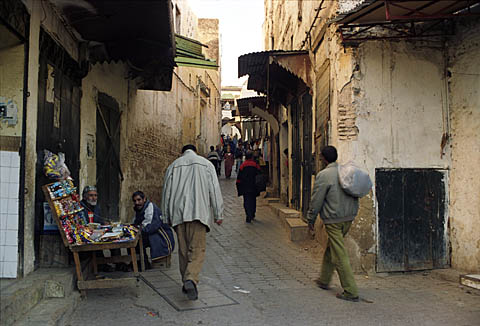
Quiet in the Markets on the Sabbath, Fes-al-Bali, Morocco
This photograph was taken deep in the medina, where the streets are very narrow. Except on the sabbath, this area would be bustling until fairly late in the evening.
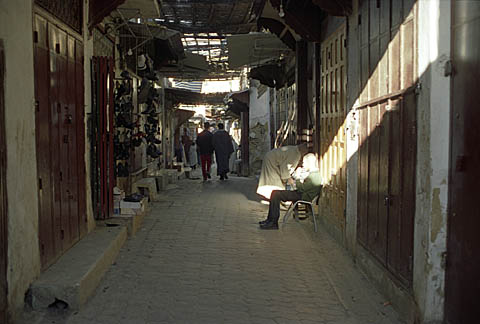
Market Street, Fes-al-Bali
This area is near the souks, almost in the heart of the medina. When the shops are open, these streets can be difficult to pass on foot, let alone with a loaded donkey, although they, too, manage to find a way through. The streets are shaded from the burning noonday sun in this region that borders on the Sahara Desert.
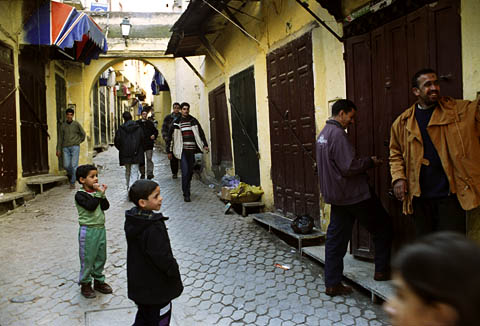
The Market on Friday, Fes-al-Bali
The streets are not uniformly wide, a characteristic that can be observed in nearly all old urban areas. Even cities laid out on a rigid grid by the Romans had often morphed into irregular streets by the Middle Ages. There are occasional seemingly-random widenings of the streets, but these areas are in fact very small squares, where life is often even more concentrated than in the streets.
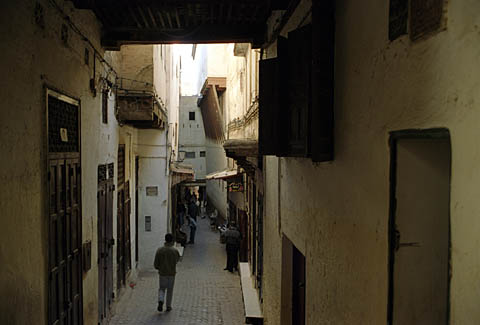
Street, Fes-al-Bali
Quite a few buildings are actually build across the street, as here. This provides additional shelter for the streets while increasing floor area at low cost.
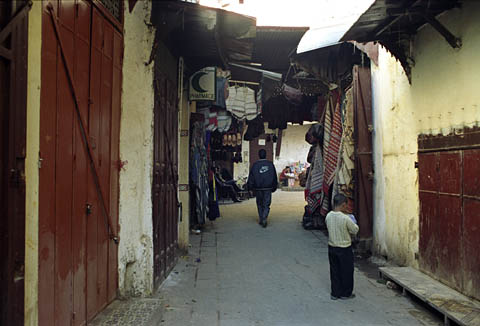
A Street Near the Central Souks, Fes-al-Bali
This is the area right in the heart of the medina, just a short distance from the souk. The streets are about three meters wide, and every available inch of frontage is given over to shops of almost every conceivable kind.
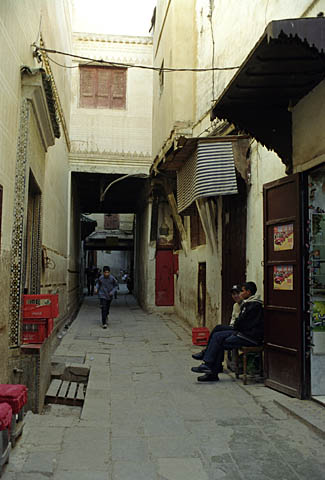
Secondary Street, Fes-al-Bali
This is a major side street of typical form. Despite the very narrow street, people find room to set a chair at the edge of the street.
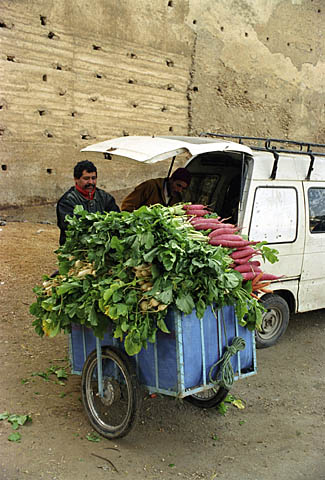
Freight Transfer, Just Outside the Gates, Fes-al-Bali
Here a hand cart is being loading with fresh produce delivered by minivan from the outlying farms. The wheels appear to be taken from a discarded motorcycle. Morocco does not recycle, it reuses, the most efficient form of material use.
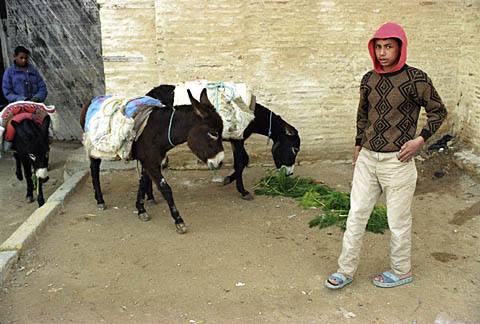
Boys & Donkeys, Fes-al-Bali
Donkeys are used for the heavier loads, and their masters are often fairly young boys. Comparatively few Moroccans receive more than elementary education.
|















